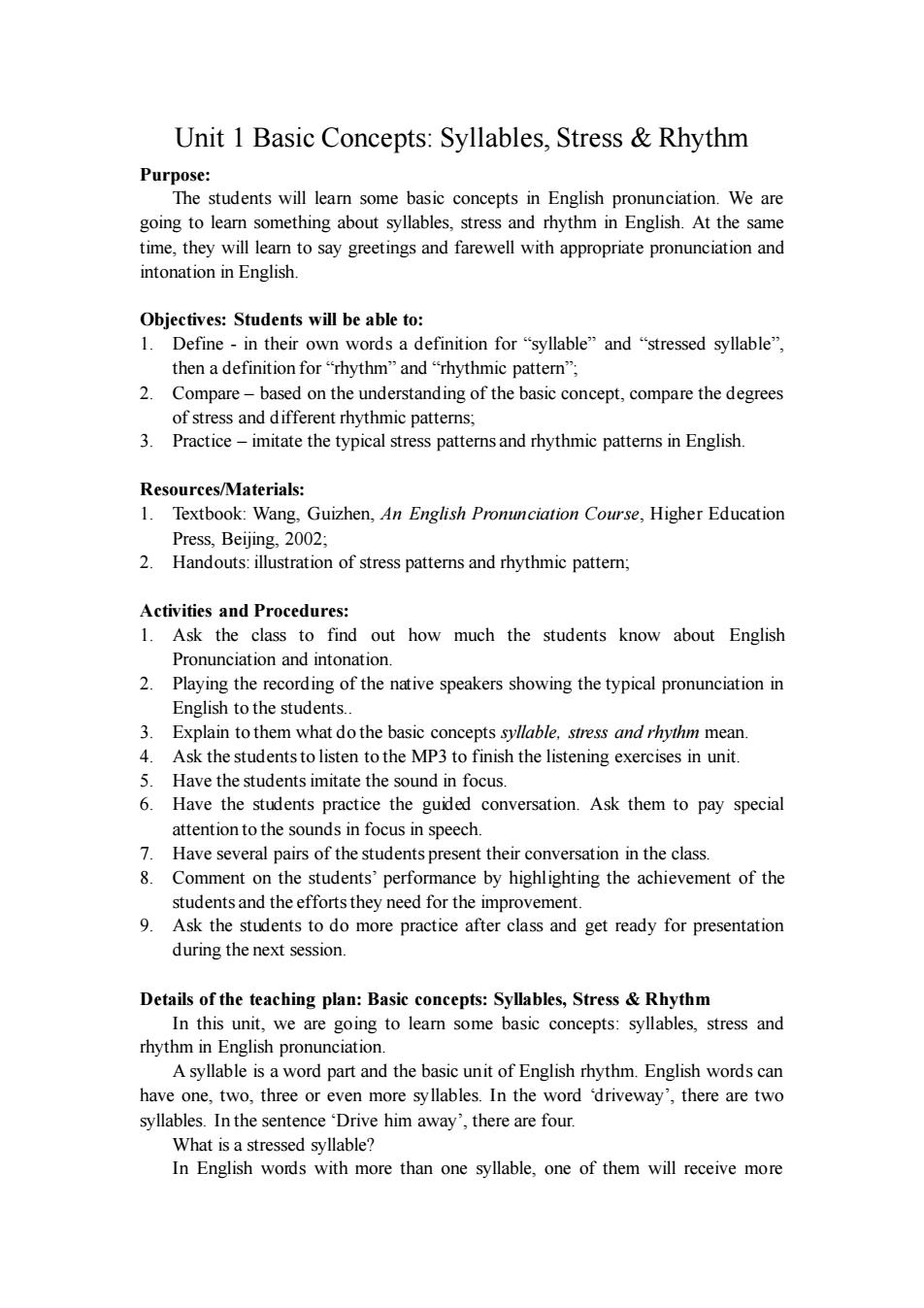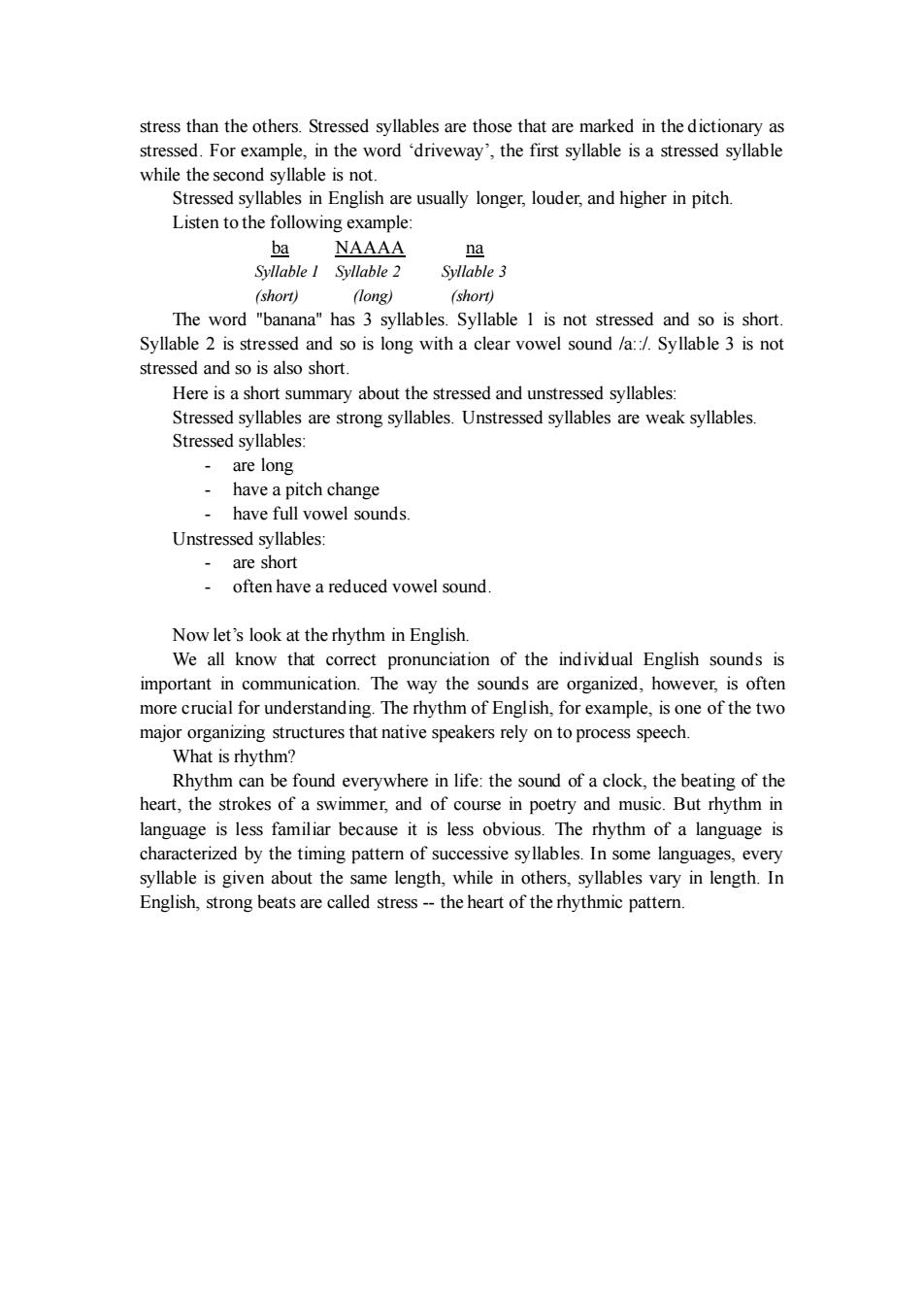
Unit 1 Basic Concepts:Syllables,Stress Rhythm Purpose: The students will leam some basic concepts in English pronunciation.We are going to learn something about syllables,stress and rhythm in English.At the same time,they will learn to say greetings and farewell with appropriate pronunciation and intonation in English. Objectives:Students will be able to: L.Define-in their own words a definition for“syllable”and“stressed syllable'”, then a definition for"“rhythm”and“rhythmic pattern', 2.Compare-based on the understanding of the basic concept compare the degrees md thme ptte in lih 3. Resources/Materials: 1 Textbook Wang.Guizhen An english pronunciation Course.Higher education 2. Handouts: ustration of stress pattems and rhythmic patter; Activities and Procedures: 1.Ask the class to find out how much the students know about English Pronunciation and intonation. 2. Playing the recording of the native speakers showing the typical pronunciation in English to the students. 3.Explain to them what do the basic concepts syllable,stress and rhythm mean. 4.Ask the students to listen to the MP3 to finish the listening exercises in unit. 5.Have the students imitate the sound in focus. students practice the guided conversation.Ask them to pay special attention to the sounds in focus in speech. 7.Have several pairs of the students present their conversation in the class. 8.Comment on the students'performance by highlighting the achievement of the students and the efforts they need for the improvement Ask the students to do more practice after class and get ready for presentation during the next session Details of the teaching plan:Basic concepts:Syllables,Stress &Rhythm In this unit,we are going to leamn some basic concepts:syllables,stress and rhythm in English pronunciation Asyllable is a word part and the basic unit of English rhythm.English words can have one,two,three or even more syllables.In the word 'driveway',there are two syllables.In the sentence'Drive him away',there are four. What is a stressed syllable? In English words with more than one syllable,one of them will receive more
Unit 1 Basic Concepts: Syllables, Stress & Rhythm Purpose: The students will learn some basic concepts in English pronunciation. We are going to learn something about syllables, stress and rhythm in English. At the same time, they will learn to say greetings and farewell with appropriate pronunciation and intonation in English. Objectives: Students will be able to: 1. Define - in their own words a definition for “syllable” and “stressed syllable”, then a definition for “rhythm” and “rhythmic pattern”; 2. Compare – based on the understanding of the basic concept, compare the degrees of stress and different rhythmic patterns; 3. Practice – imitate the typical stress patterns and rhythmic patterns in English. Resources/Materials: 1. Textbook: Wang, Guizhen, An English Pronunciation Course, Higher Education Press, Beijing, 2002; 2. Handouts: illustration of stress patterns and rhythmic pattern; Activities and Procedures: 1. Ask the class to find out how much the students know about English Pronunciation and intonation. 2. Playing the recording of the native speakers showing the typical pronunciation in English to the students. 3. Explain to them what do the basic concepts syllable, stress and rhythm mean. 4. Ask the students to listen to the MP3 to finish the listening exercises in unit. 5. Have the students imitate the sound in focus. 6. Have the students practice the guided conversation. Ask them to pay special attention to the sounds in focus in speech. 7. Have several pairs of the students present their conversation in the class. 8. Comment on the students’ performance by highlighting the achievement of the students and the efforts they need for the improvement. 9. Ask the students to do more practice after class and get ready for presentation during the next session. Details of the teaching plan: Basic concepts: Syllables, Stress & Rhythm In this unit, we are going to learn some basic concepts: syllables, stress and rhythm in English pronunciation. A syllable is a word part and the basic unit of English rhythm. English words can have one, two, three or even more syllables. In the word ‘driveway’, there are two syllables. In the sentence ‘Drive him away’, there are four. What is a stressed syllable? In English words with more than one syllable, one of them will receive more

stress than the others.Stressed syllables are those that are marked in the dictionar stressed.For exa mlin the word "dnveway the irst seisa stressed sy while the second syllable is not Stressed syllables in English are usually longer,louder,and higher in pitch. Listen to the following example: ha NAAAA Syllable 1 Syllable 2 (long) (short) The word "banana"has 3 syllables.Syllable 1 is not stressed and so is short Syllable 2 is stressed and so is long with a clear vowel sound /a::/.Syllable 3 is not stressed and so is also short. Here is a short summary about the stre ssed and unstressed syllables Stressed syllab es are strong syllables.Unstressed syllables are weak syllables Stressed syllables are long have a pitch change have full vowel sounds Unstressed syllables are shon often have a reduced vowel sound Now let's look at the rhythm in English. We all know that e of the indivdual important in communication.The way the sounds s are organized. however,is often more crucial for understanding.The rhythm of English.for example.is one of the two major organizing structures that native speakers rely on to process speech. What is rhythm? Rhythm can be found in life:the sound of a beating of th heart,the strokes of a swimmer,and of course in poetry and music But rhythmn language is less familiar because it is less obvious.The rhythm of a language is characterized by the timing pattern of successive syllables.In some languages.every syllable is given about the same length,while in others,syllables vary in length.In English,strong beats are called stress-the heart of the rhythmic patter
stress than the others. Stressed syllables are those that are marked in the dictionary as stressed. For example, in the word ‘driveway’, the first syllable is a stressed syllable while the second syllable is not. Stressed syllables in English are usually longer, louder, and higher in pitch. Listen to the following example: ba NAAAA na Syllable 1 Syllable 2 Syllable 3 (short) (long) (short) The word "banana" has 3 syllables. Syllable 1 is not stressed and so is short. Syllable 2 is stressed and so is long with a clear vowel sound /a::/. Syllable 3 is not stressed and so is also short. Here is a short summary about the stressed and unstressed syllables: Stressed syllables are strong syllables. Unstressed syllables are weak syllables. Stressed syllables: - are long - have a pitch change - have full vowel sounds. Unstressed syllables: - are short - often have a reduced vowel sound. Now let’s look at the rhythm in English. We all know that correct pronunciation of the individual English sounds is important in communication. The way the sounds are organized, however, is often more crucial for understanding. The rhythm of English, for example, is one of the two major organizing structures that native speakers rely on to process speech. What is rhythm? Rhythm can be found everywhere in life: the sound of a clock, the beating of the heart, the strokes of a swimmer, and of course in poetry and music. But rhythm in language is less familiar because it is less obvious. The rhythm of a language is characterized by the timing pattern of successive syllables. In some languages, every syllable is given about the same length, while in others, syllables vary in length. In English, strong beats are called stress - the heart of the rhythmic pattern